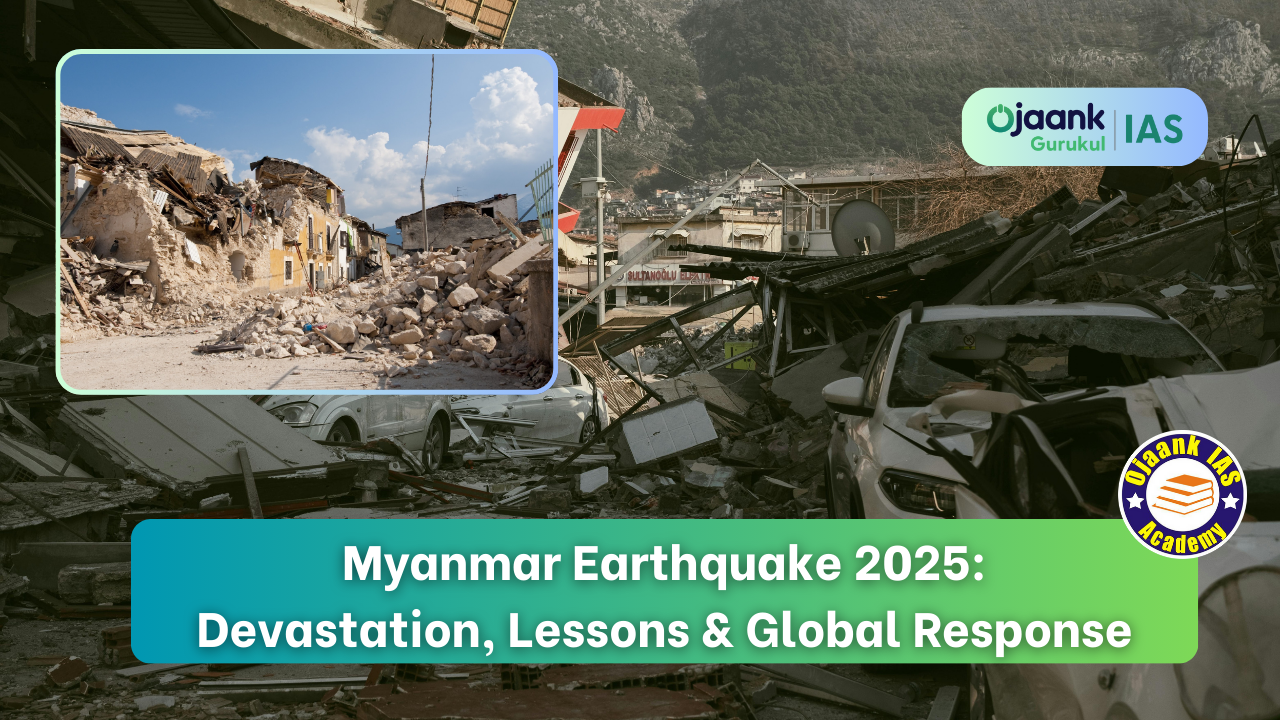Myanmar Earthquake 2025: Devastation, Lessons & Global Response

Introduction: A Wake-Up Call from the Earth’s Depths
In the wake of the catastrophic 7.7-magnitude earthquake that struck Myanmar, the region has been thrown into chaos. With more than 1,600 lives lost and 3,400 injured, the disaster is a grim reminder of the devastating power of nature and the high cost of unpreparedness. As fractured buildings collapse and cities like Mandalay and Naypyitaw plunge into darkness, the world is watching and responding. But beyond the shock lies a deeper lesson — one that goes beyond fault lines and tectonic plates.
The Epicenter of Tragedy: Myanmar’s Seismic Vulnerability
Myanmar sits at the confluence of four major tectonic plates: the Eurasian, Indian, Sunda, and Burma microplate. This geotectonic positioning makes the country highly susceptible to earthquakes. The Sagaing Fault, one of the region’s most active seismic zones, has been the origin of at least six to eight major quakes since 1900, according to the U.S. Geological Survey.
What makes this quake particularly alarming isn’t just the magnitude, but the extent of its destruction to urban infrastructure. Entire communities have been reduced to rubble. Hospitals are overwhelmed. Displaced citizens are sleeping in the open. This was not merely a natural event — it was a stress test on Myanmar’s national resilience.
Read more about Myanmar’s tectonic vulnerability and seismic risks.
Global Response: A Glimmer of Hope Amidst Rubble
In a swift and compassionate display of international solidarity, neighboring nations including India, China, and Thailand mobilized rescue teams, warships, and military aircraft packed with relief supplies. Indian military aircraft conducted multiple sorties to Naypyitaw, delivering essential aid and personnel. Chinese rescue teams, including overland units from Yunnan province, were among the first responders on the ground.
Thailand, too, faced secondary consequences as a skyscraper under construction in Bangkok collapsed despite being over 1,000 km away from the epicenter — proving once again that earthquakes don’t recognize borders.
Explore how India, China, and Thailand are aiding Myanmar’s earthquake victims.
The Hard Truth: Political Instability Worsens Natural Disasters
Since the military coup of 2021, Myanmar has seen deep political instability. Governance has taken a back seat, and critical sectors like infrastructure regulation, urban planning, and building code enforcement have been severely undermined. In any other nation with stable governance, earthquake-resistant structures and well-planned emergency response systems could have saved hundreds of lives.
This disaster underscores a harsh reality: Earthquakes don’t kill people — poorly built buildings do. The lack of preparedness and weak enforcement of seismic safety standards turned a natural event into a national tragedy.
Read more about how Myanmar's political crisis worsens disaster resilience.
Science vs. Seismic Events: Can We Predict the Next One?
While accurately predicting earthquakes remains scientifically impossible, risk modeling and probability assessments are well within our current capabilities. We know where earthquakes are likely to strike. We know how to build safer cities. The issue isn’t knowledge — it’s implementation.
Countries like Japan and Chile, both in seismically active zones, have successfully invested in quake-resilient infrastructure. The blueprint exists. What Myanmar needs now is political will, international investment, and a governance overhaul to adopt these systems.
The Silver Lining: Seize the Ceasefire, Build the Future
Amidst the ruins, there is a fragile hope. The current ceasefire in Myanmar could be the opening the country desperately needs. A more stable political climate can bring in foreign investment, global expertise, and allow for regulatory reform — all essential to rebuilding stronger, safer, and smarter.
This is not just about recovery; it’s about future-proofing the nation. Myanmar has a chance to transform this tragedy into a turning point — if it acts decisively now.
Key Takeaways:
-
Myanmar's 7.7-magnitude earthquake has caused catastrophic damage and a mounting death toll.
-
The country lies at the intersection of four major tectonic plates, making it seismically vulnerable.
-
International aid from India, China, and Thailand has provided rapid assistance.
-
Political instability has weakened disaster preparedness and infrastructure resilience.
-
Investment in seismic-safe construction and governance reform is urgent.
-
The ceasefire presents a rare opportunity to build a more resilient Myanmar.
Conclusion: Nature’s Fury, Humanity’s Responsibility
Natural disasters will continue to occur. But whether they become national tragedies or just news headlines depends entirely on our preparation. The Myanmar earthquake is a grim lesson in what happens when politics overshadows policy, and when warnings go unheeded. The future doesn't belong to the most powerful — it belongs to the most prepared.
Let this quake not just be a story of loss, but a catalyst for change, resilience, and renewed global cooperation.
If this resonated with you or you're looking to stay updated on disaster preparedness, geopolitical analysis, and climate resilience, follow our blog and share this article to raise awareness.
Get the latest news on the Myanmar earthquake and its aftermath.
#MyanmarEarthquake2025 #DisasterPreparedness #TectonicPlates #AsiaCrisis #GlobalAid #SagaingFault #MyanmarPolitics #ResilientCities #QuakeLessons
//////////////////////////////
Blog Collection
Copyright 2022 power by Ojaank Ias




